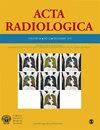超快磁共振成像和传统 DCE-MRI 对预测乳腺癌患者组织学侵袭性的实用性。
IF 1.1
4区 医学
Q3 RADIOLOGY, NUCLEAR MEDICINE & MEDICAL IMAGING
引用次数: 0
摘要
目的确定超快速和传统动态对比增强磁共振成像(DCE-MRI)中可预测乳腺癌患者组织病理学预后标志物的重要特征。材料与方法对 2021 年 2 月至 2022 年 8 月间连续 158 名女性(平均年龄 = 54.0 岁;年龄范围 = 29-86 岁)163 例乳腺癌患者的术前 MRI 扫描进行了回顾性审查。两名放射科医生对超快磁共振成像参数的观察者间一致性进行了分析。结果超快磁共振成像参数的观察者间一致性极佳(动力学曲线下面积[AUC]、最大斜率[MS]、最大增强[ME]和斜率的类内相关系数分别为0.987、0.844、0.822和0.760)。与管腔癌相比,三阴性乳腺癌(TNBC)与边缘强化(几率比 [OR] = 9.4,P = 0.003)和瘤周水肿(OR = 17.9,P = 0.002)显著相关。与原位癌相比,浸润癌与病变类型-质量、延迟冲洗增加、血管体积、ME、斜率、MS 和 AUC 相关。在回归分析中,MS(>46.2%/s)(OR = 5.7,P = 0.046)和延迟冲洗(>17.5%)(OR = 17.6,P = 0.01)的组合,以及AUC(>27,410.3)(OR = 9.6,P = 0.04)、延迟冲洗(>17.5%)(OR = 8.9,P = 0.009)和病变类型肿块(OR = 4.6,P = 0.04)可预测组织学侵袭性。结论常规DCE-MRI与超快速成像可为预测组织学低估和侵袭性分子亚型提供有用信息。超快磁共振成像上的 MS 和 AUC 可作为潜在的成像标记,预测组织学上从 DCIS 升级为浸润性癌症,可靠性高。本文章由计算机程序翻译,如有差异,请以英文原文为准。
The utility of ultrafast MRI and conventional DCE-MRI for predicting histologic aggressiveness in patients with breast cancer.
BACKGROUND
Prediction of histologic prognostic markers is important for determining management strategy and predicting prognosis.
PURPOSE
To identify important features of ultrafast and conventional dynamic contrast-enhanced magnetic resonance imaging (DCE-MRI) that can predict histopathologic prognostic markers in patients with breast cancer.
MATERIAL AND METHODS
Preoperative MRI scans of 158 consecutive women (mean age = 54.0 years; age range = 29-86 years) with 163 breast cancers between February 2021 and August 2022 were retrospectively reviewed. Inter-observer agreements for ultrafast MRI parameters were analyzed by two radiologists. The qualitative and quantitative MRI parameters were correlated with histopathologic prognostic markers including molecular subtypes and histologic invasiveness.
RESULTS
Inter-observer agreements for ultrafast MRI parameters were excellent (intraclass correlation coefficients of area under the kinetic curve [AUC], maximum slope [MS], maximum enhancement [ME], and slope = 0.987, 0.844, 0.822, and 0.760, respectively). Triple-negative breast cancers (TNBC) were significantly associated with rim enhancement (odds ratio [OR] = 9.4, P = 0.003) and peritumoral edema (OR = 17.9, P = 0.002), compared to luminal cancers. Invasive cancers were associated with lesion type-mass, increased delayed washout, angiovolume, ME, slope, MS, and AUC, compared to in situ cancers. In regression analysis, the combination of MS (>46.2%/s) (OR = 5.7, P = 0.046) and delayed washout (>17.5%) (OR = 17.6, P = 0.01), and that of AUC (>27,410.3) (OR = 9.6, P = 0.04), delayed washout (>17.5%) (OR = 8.9, P = 0.009), and lesion-type mass (OR = 4.6, P = 0.04) were predictive of histologic invasiveness.
CONCLUSION
Conventional DCE-MRI with ultrafast imaging can provide useful information for predicting histologic underestimation and aggressive molecular subtype. MS and AUC on ultrafast MRI can be potential imaging markers for predicting histologic upgrade from DCIS to invasive cancer with high reliability.
求助全文
通过发布文献求助,成功后即可免费获取论文全文。
去求助
来源期刊

Acta radiologica
医学-核医学
CiteScore
2.70
自引率
0.00%
发文量
170
审稿时长
3-8 weeks
期刊介绍:
Acta Radiologica publishes articles on all aspects of radiology, from clinical radiology to experimental work. It is known for articles based on experimental work and contrast media research, giving priority to scientific original papers. The distinguished international editorial board also invite review articles, short communications and technical and instrumental notes.
 求助内容:
求助内容: 应助结果提醒方式:
应助结果提醒方式:


